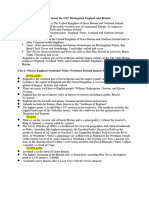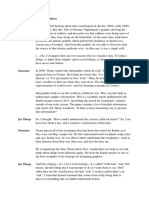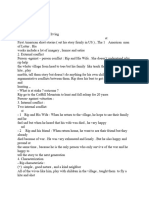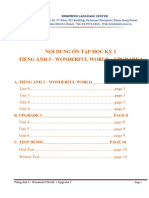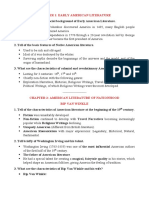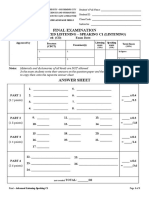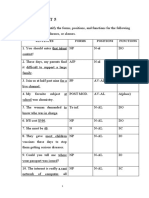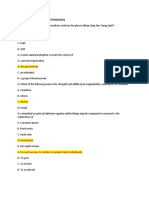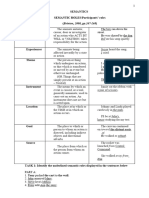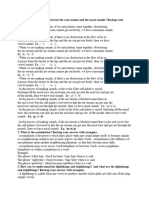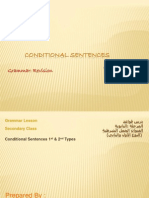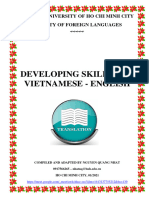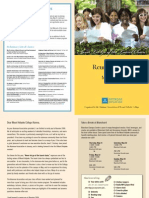The Society and Culture of Major English-Speaking Countries: Say in Brief What
Uploaded by
Văn HảiThe Society and Culture of Major English-Speaking Countries: Say in Brief What
Uploaded by
Văn HảiESC1.03.
18
The Society and Culture of Major English-Speaking Countries
Question 1:
Part 1
Say in brief what you know about the foundation of the UK
4th century BC: Britain = Briton, and the people here were called Britons.
They belong to the Celtic race
1st century AD (43): Briton was invaded by the Roman Empire. England
and Wales (though not Scotland or Ireland) became a part of the Roman
Empire for nearly 400 years.
5th century AD (410): Anglo-Saxon invasion - Germanic peoples: the
Angles, and the Saxon.
They were powerful → They divided the country into 2 parts:
- Anglo-Saxon area in England
- Celtic area in Wales, Scotland, and Ireland.
The Welsh:
• escaped to the wild mountains of Wales to defend their freedom for 1000
years.
• In 1536, they were conquered by the English
The Scottish
• Scotland was not conquered by the Romans or the Anglo-Saxons
• In 1707 the English and Scottish parliaments decided to form a union based
on agreement → Great Britain was established
The Irish:
• In 17th century, English and Scottish Protestants were sent to Northern
Ireland to stop Irish Catholics from causing trouble.
• The Irish Protestants helped the English and Scottish Protestants → Irish
Catholics were defeated → had to escape to the South (Republic of Ireland)
• In 1801 Ireland became part of UK
• In 1921, Ireland was divided into 2 parts:
- Northern Ireland: belonging to UK
- Republic of Ireland/Irish Republic: independent
Part 2
Theresa Mary May (/təˈriːzə/;[1] née Brasier /ˈbreɪʒər/; born 1 October 1956) is a
British politician serving as Prime Minister of the United Kingdom and Leader of
the Conservative Party since 2016.
1
ESC1.03.18
The Society and Culture of Major English-Speaking Countries
Question 2
Part 1
What do you know about the discovery of Australia and New
Zealand?
Australia: the largest island; the smallest, flattest and driest continent in the
world.
Australia has six states and two major mainland territories.
Australia is surrounded by the sea → far away from the main trade routes
→ a big continent but not be discovered until 17th century.
It was believed that there was a Great South Land where civilised human
beings lived → a lot of expeditions were sent to the South to look for this
land/to confirm its existence.
In 1642, a Dutch explorer, Tasman, discovered part of Aus. and NZ →
they didn’t settle down because the land they discovered was barren and
uninviting/inhospitable.
In 1768, James Cook was sent to look for this land → In 1769, he
discovered NZ. He met the Maoris: native people in NZ coming from the
South Pacific Islands in the 14th century – they were very warlike.
He continued his voyage and hoped, with luck, he could find another land.
In 1770, he discovered Aus. and landed in a bay → saw strange plants and
creatures → he named it Botany Bay. They met Aborigines: native people
in Aus. coming from Asia more than 40,000 years ago → they were simple
and peaceful
He named New South Wales and claimed Aus. for British government.
Part 2
The flag of the United Kingdom of Great Britain and Northern Ireland, commonly known
as the Union Jack or Union Flag, is the national flag of the United Kingdom. It is made
up from the flags of England, Scotland and Northern Ireland.
2
ESC1.03.18
The Society and Culture of Major English-Speaking Countries
Question 3
Part 1
Why did Northern Ireland become part of the UK?
From the time of Queen Elizabeth I (late 1590s) the new settlers, loyal to
the British crown and Protestants in religious persuasion, were granted
land, position, and privileges (from Roman Catholic)
In 17th century, English and Scottish Protestants were sent to Northern
Ireland to stop Irish Catholics from causing trouble.
Fighting: English and Scottish Protestants against Irish Catholics
The Irish Protestants helped the English and Scottish Protestants, so Irish
Catholics were defeaded. Irish Catholics had to escape to the South
(Republic of Ireland)
In 1801 Ireland became part of UK.
Until 1921 the UK was "The United Kingdom of Great Britain and
Ireland", not only "Northern Ireland".
In 1921, Ireland was divided into 2 parts:
- Northern Ireland: belonging to UK
- Republic of Ireland/ Irish Republic: independent
Part 2
It is Canada’s flag. It has been Canada’s flag since February 15 th 1965. There are 2
colours on it: White and red. Maple tree (leaf) is Canada’s official one.
3
ESC1.03.18
The Society and Culture of Major English-Speaking Countries
Question 4
Part 1
What are the roles and powers of the Queen? Why does she reign but not
rule?
The Queen:
represents Britain at home and abroad;
sets standards of good citizenship and family life
In law, the Queen is:
- head of state
- head of the executive and the judiciary
- head of the Church of England
- commander-in-chief of the armed forces
The Queen’s remaining powers:
- to summon, prorogue or dissolve the Parliament;
- to give Royal Assent/Agreement to legislation passed by the Par.;
- to appoint importain positions;
- to confer honours;
- to remit sentences;
- to declare war or make peace;
but all are under the Parliament’s control or direction
The Queen reigns but doesn’t rule
In 16th and 17th centuries: a struggle for power between the Monarch and the
Parliament. The Par. controlled most of national wealth so the Par. won.
The Par. allowed the Monarch to continue to function but within certain limits/
under the Par.’s control
Part 2
The name Big Ben is often used to describe the tower, the clock and the bell but the name
was first given to the Great Bell.
4
ESC1.03.18
The Elizabeth Tower, which stands at the north end of the Houses of Parliament, was
completed in 1859 and the Great Clock started on 31 May, with the Great Bell's strikes
heard for the first time on 11 July and the quarter bells first chimed on 7 September.
5
ESC1.03.18
The Society and Culture of Major English-Speaking Countries
Question 5
Part 1
What do you know about the British Parliament and the Prime
Minister?
The Parliament
The Parliament today consists of the Queen, the House of Lords and the
House of Commons.
House of Lords (unelected members) consists of about 1185 hereditary and
life peers and peeresses; 2 Archbishops ; and 24 most senior bishops.
House of Commons: consist of 651 elected members from 651
constituences. They becomes Members of Parliament (MPs)
Par. is the seat of British democracy
The House of Lords was created to provide a council of the nobility for the
King.
The Commons was summoned to provide the King with money.Because of
the financial power, from 17th century, the Commons gained power in
matters of finance as well as of legislation over both the Monarch and the
Lords.The Commons can force the government to resign by passing a
resolution of “no confidence”.
Parliament’s functions:
- to pass laws
- to raise monney through taxation to enable the government to function.
- to examine the government policy, administration and expenditure
- to debate or discuss major political issues.
The Prime Minister:
- the most powerful
- leader of the winning/ majority Party in the general election
- appoints about 100 ministers
6
ESC1.03.18
- chooses about 20 among the ministers to form the Cabinet
Part 2
She is Queen Elizabeth II, the head of the U.K, Australia and New Zealand, and
Head of the Commonwealth. She is also Queen of 12 countries that have become
independent since her accession.
7
ESC1.03.18
The Society and Culture of Major English-Speaking Countries
Question 6
Part 1
What do you know about the making of Canada? Why do the
Canadians have two systems of everything?
The first White settlers: The French:
- 1534 the French explorers arrived met Indians, they were welcomed but
they kidnapped Indians chiefs. They treated Indians with cruelty and
treachery
- 1603 French fur-trading settlements were established in Canada very
profitable
- First British settlers are American refugees. They didn’t take part in
American Revolution they called themselves Loyalists, but they were
called traitors.
- Middle 17th century, French settlers were sent to Canada to supply for fur-
traders with food and shelter.
1764 French fighting with British in North of America (Canada) French
was defeated
- When French was defeated Canada belonged to British Government but
they were allowed to keep (to stay on) their traditions and to speak their
language Canada is a bilingual country (2 systems of everything)
- First British settlers are American refugees. They didn’t take part in
American Revolution they called themselves Loyalists, but they were
called traitors.
8
ESC1.03.18
- In 1936 Canada became self-governing nation in the British
Commonwealth (because the British didn’t forget how they had lost
America)
Part 2
Australian flag is also called the Commonwealth Blue Ensign. It has three main
design elements on a deep blue background:
The British Union Jack flag is in the upper left corner - noting Australia's
ties to Great Britain
The Southern Cross constellation (5 stars) is on the right side of the flag -
the Southern Cross is a major navigational constellation in the Southern
Hemisphere
The large, white, seven-pointed Commonwealth Star (also called the Star of
Federation) - it is symbolic of the original states of Australia.
9
ESC1.03.18
The Society and Culture of Major English-Speaking Countries
Question 7
Part 1
Please define “absolute decline and relative decline” in the UK
economy. What are the reasons for the absolute decline and relative
decline?
By the 1880s the British economy was dominant in the world, producing
one third of the world's manufactured goods, half its coal and iron, half its
cotton.
From 1945 until the present, the UK economy is usually thought of as one
of decline:
- First, the country had gone heavily into debt in order to finance the war.
- Second, the era of empire was over. India, popularly known as "The
Jewel in the Crown" of the British Empire, gained its independence in
1947, only 2 years after the end of the war
- Third, Britain was still forced to maintain a substantial and expensive
military presence in many overseas locations
- Fourth, although Britain was quite badly damaged by German bombing
during the war, its industry survived comparatively unaffected. British
industry could continue with its older factories and pre-war products,
and given its other economic problems.
In fact, this was not an absolute decline: Britain is not poorer, or producing
less than it was in 1945, but it is a lot wealthier and more productive than it
was then.
It has in fact been a period of steady economic growth and rapidly
increasing living standards.
British economy has improved, but other countries have improved more
rapidly (from being the 2nd largest economy to being the sixth).
10
ESC1.03.18
The UK has experienced economic decline, but this decline is relative to
some other economies rather than absolute.
Part 2
John Fitzgerald "Jack" Kennedy, commonly referred to by his initials JFK, was an
American politician who served as the 35th President of the United States from
January 1961 until his assassination in November 1963
11
ESC1.03.18
The Society and Culture of Major English-Speaking Countries
Question 8
Part 1
What do you know about the native people living in the icy land in
Canada? (their origin, the life in the past and now....)
In the icy land (far north): the Inuit (Eskimo).
The Eskimo prefer to be called Inuit. “Eskimo” means “eaters of raw
flesh/meat”; “Inuit” means “the people”.
In the past, they used to be nomads:
travelling from place to place;
hunting seals and caribou;
living in tents made of caribou skins;
being cheerful and happy.
The white arrived → they brought with them guns and machinery → found
gas and natural oil. It affected Inuit’s life:
giving up living as nomads to live in settlements;
not hunting;
spending time drinking in the pubs;
being unhappy.
Now:
hunting again with gun, snowmobiles, and canned food;
living in towns built by the government;
being trained for many kinds of jobs;
children going to school;
health being looked after.
Aboriginal peoples are still Canada's poorest inhabitants
→ International human rights groups and the United Nations have criticized
the Canadian government's systematic discrimination against its native
population.
12
ESC1.03.18
Most Canadians agree that they have been treated badly for far too long
→ it is time for a change.
Part 2
Buckingham Palace is the London residence and principal workplace of the
reigning monarch of the United Kingdom. Located in the City of Westminster, the
palace is often at the centre of state occasions and royal hospitality.
13
ESC1.03.18
The Society and Culture of Major English-Speaking Countries
Question 9:
Part 1
What do you know about the present British education system?
What is the Open University in Britain?
Present Education System
Education in the UK is compulsory, from the ages of 5 (4 in Northern
Ireland) to 16.
Parents can choose between sending their children to state schools or to
private schools.
Independent schools are commonly called public schools.
Up to age 5, children may have some pre-primary schooling in nursery
schools, daycare, or play groups.
Between the ages of 5 to 11, pupils mainly attend state sector primary
schools.
From the age of 11 up to around the age of 19, students attend secondary
schools.
After 5 years of secondary education, (at about age 16) English, Northern
Irish and Welsh students sit their GCSE exams (General Certificate of
Secondary Education).
Based on these results, pupils can have a number of choices: to quit school
and find a job; or to sit exams for university entrance; or to concentrate on
vocational training.
The Open University offers a non-traditional route for people to take university
level courses and receive a university degree. People can register without
having any formal educational qualifications.
Part 2
The University of Oxford (informally Oxford University or simply Oxford) is a
collegiate research university located in Oxford, England. While having no known
date of foundation, there is evidence of teaching as far back as 1096, making it the
oldest university in the English-speaking world and the world's second-oldest
surviving university.
14
ESC1.03.18
The Society and Culture of Major English-Speaking Countries
Question 10:
Part 1:
Who were the first white settlers in Australia? Why did they move
there?
First white settlers: British convicts/prisoners
In 18th century, British society were very bad → power belonged to a
group of people → some: very rich; others were very poor → the poor had
to commit crime → number of criminal increased → prisons were
overcrowded → not enough places for prisoners → looked for a new land.
In 1786, British government decided to send prisoners to Aus.
26/01/1788, First Fleet of 11th ships with about 700 convicts/prisoners
landed in Aus. → New South Wales became a convict/penal
settlement/colony.
One first settlement → developed to six settlements (3 convict and 3 free
ones)
On 1 January 1901, the six colonies became a federation, and the
Commonwealth of Australia was formed.
The Commonwealth of Australia was born as a Dominion of the British
Empire.
Part 2:
It is the Opera House in Australia. It looks like a sail. The Sydney Opera
House is a identified as one of the 20th century's most distinctive buildings.
15
You might also like
- Common Errors On Verb Tenses and Word Choices in Vietnamese-English Translation by The Second-Year English Majors at Dong Thap University100% (1)Common Errors On Verb Tenses and Word Choices in Vietnamese-English Translation by The Second-Year English Majors at Dong Thap University81 pages
- tiến trình bài giảng Unit 6 fighting choleraNo ratings yettiến trình bài giảng Unit 6 fighting cholera23 pages
- Biên dịch - Student book - Version 2 PDFNo ratings yetBiên dịch - Student book - Version 2 PDF25 pages
- Đề cương ôn tập môn Ngữ âm lý thuyết (bản chuẩn)No ratings yetĐề cương ôn tập môn Ngữ âm lý thuyết (bản chuẩn)16 pages
- Ielts Listening-Stage 1-Listen For DictationNo ratings yetIelts Listening-Stage 1-Listen For Dictation3 pages
- Fall 2022 ENG2052 British & American StudiesNo ratings yetFall 2022 ENG2052 British & American Studies10 pages
- Đề Cương Ôn Tập K3 WW3 + Upgrade 3No ratings yetĐề Cương Ôn Tập K3 WW3 + Upgrade 319 pages
- ĐỀ THI MÔN VĂN MINH ANH - 15g00 NGÀY 19 - 1 - 2022 - CA 250% (2)ĐỀ THI MÔN VĂN MINH ANH - 15g00 NGÀY 19 - 1 - 2022 - CA 229 pages
- New - Full - Sach Intro 2 - Pragmatics and StoriesNo ratings yetNew - Full - Sach Intro 2 - Pragmatics and Stories50 pages
- Bài tập cơ bản & nâng cao thì hiện tại đơnNo ratings yetBài tập cơ bản & nâng cao thì hiện tại đơn3 pages
- Advanced Grammar - End Term Test - English Department0% (1)Advanced Grammar - End Term Test - English Department5 pages
- Topic 1: "Students Should Studying at University or College Instead of Getting A Job Straight After School." Do You Agree or Disagree?No ratings yetTopic 1: "Students Should Studying at University or College Instead of Getting A Job Straight After School." Do You Agree or Disagree?2 pages
- IELTS READING-LISTENING Practice by HungNo ratings yetIELTS READING-LISTENING Practice by Hung238 pages
- Presentation 1 Conditional Sentences Type 1-20% (1)Presentation 1 Conditional Sentences Type 1-226 pages
- Thử Thách Luyện Nghe Tiếng Anh Cơ Bản 15 Phút Mỗi Ngày-p2No ratings yetThử Thách Luyện Nghe Tiếng Anh Cơ Bản 15 Phút Mỗi Ngày-p25 pages
- Silver Tulip Hotel: 1 Double-King-Sized Francis Taxi Fri (Day) 16 AprilNo ratings yetSilver Tulip Hotel: 1 Double-King-Sized Francis Taxi Fri (Day) 16 April8 pages
- Answer + Explanation: Translation R1: Hot Days, Hot NightsNo ratings yetAnswer + Explanation: Translation R1: Hot Days, Hot Nights2 pages
- Internal Empire: The Rise and Fall of English ImperialismFrom EverandInternal Empire: The Rise and Fall of English ImperialismNo ratings yet
- Education and Motherhood: Struggles of Mothers in Pursuit of College EducationNo ratings yetEducation and Motherhood: Struggles of Mothers in Pursuit of College Education9 pages
- Namemail Id Alternate Date of Birth Mobile No Functionalarea of Speindustry Resume Titkey SkillsNo ratings yetNamemail Id Alternate Date of Birth Mobile No Functionalarea of Speindustry Resume Titkey Skills17 pages
- Download Comprehensive Healthcare Simulation Program Center Development 1st Edition Michael A. Seropian ebook All Chapters PDF100% (3)Download Comprehensive Healthcare Simulation Program Center Development 1st Edition Michael A. Seropian ebook All Chapters PDF52 pages
- University of Kerala: Results of Tenth Semester Examination April 2022No ratings yetUniversity of Kerala: Results of Tenth Semester Examination April 202213 pages
- Download full Byzantine Matters Averil Cameron ebook all chapters100% (2)Download full Byzantine Matters Averil Cameron ebook all chapters55 pages
- UG - Direct Admission 2019 - Phase II - NotificationNo ratings yetUG - Direct Admission 2019 - Phase II - Notification4 pages
- Oxford Solutions Int Unit 8D Reported QuestionsNo ratings yetOxford Solutions Int Unit 8D Reported Questions2 pages
- 'Physio Research Summit 2025' - Dec-2024 - Brochure (3)No ratings yet'Physio Research Summit 2025' - Dec-2024 - Brochure (3)6 pages
- Instant Access to Actional Poetics ASH SHE HE The Performance Actuations of Alastair MacLennan 1971 2020 1st Edition Sandra Johnston ebook Full ChaptersNo ratings yetInstant Access to Actional Poetics ASH SHE HE The Performance Actuations of Alastair MacLennan 1971 2020 1st Edition Sandra Johnston ebook Full Chapters67 pages
- Japanese University Student Responses To Intercultural Scenarios Contact Strategies and Perceptions of OthernessNo ratings yetJapanese University Student Responses To Intercultural Scenarios Contact Strategies and Perceptions of Otherness13 pages
